Experience the magic of homemade comfort with our Rivel Soup recipe! Delicate dumplings, known as “rivels,” float gracefully in a warm, savory broth, creating a symphony of simplicity and flavor. Each spoonful is a journey through time, reminiscent of grandma’s kitchen and cozy Sunday afternoons. Embrace the warmth, savor the nostalgia, and let the tiny rivels melt in your mouth like clouds in a comforting culinary dream. It’s not just soup; it’s a cherished tradition, ready to whisk you away on a flavorful trip down memory lane.
The kitchen fills with an enticing aroma. It’s unmistakably the scent of comfort and nostalgia. The pot simmers, each bubble telling tales of traditional culinary mastery.

It’s an experience. This masterpiece has won hearts across continents. Whether seeking solace on a cold day or a trip down memory lane, Rivel soup is the answer. Ingredients whisper stories of rustic kitchens and age-old cooking secrets. Simple, yet profound.
The soup promises warmth, comfort, and heritage in every spoonful. Dive into this recipe, and let your taste buds embark on an unforgettable journey. Welcome to the timeless world of Rivel soup. Your adventure awaits.
What Is A Rivel Soup Recipe?
Rivel soup, a staple in Pennsylvania Dutch cuisine, is a simple, hearty dish. It features tiny dough balls or “rivels” made from flour and egg, scattered into a simmering chicken or ham broth pot.
As they cook, the rivels swell, giving the soup a delightful, dumpling-like texture. Often associated with comfort and tradition, this soup is a testament to the beauty of basic ingredients coming together. It’s a warm embrace in a bowl, cherished by many for its nostalgic charm.

Can You Vary The Recipe With Other Ingredients?
Rivel Soup can be adapted to various dietary preferences. Here’s how you can modify the recipe to fit Keto, Paleo, Gluten-Free, Whole30, Vegetarian, and Vegan diets:
Keto
- Flour: Substitute all-purpose flour with almond or coconut flour for the rivels.
- Corn: Omit corn as it’s high in carbs. You can add low-carb vegetables like zucchini or cauliflower.
Paleo
- Flour: Use cassava flour or almond flour for the rivels.
- Corn: Replace with another vegetable, as corn is not typically paleo-friendly. Consider diced carrots or celery.
Gluten-Free
- Flour: Use a gluten-free flour blend or rice flour for the rivels. Ensure the flour binds well; depending on the blend, xanthan gum might be necessary.
Whole30
- Flour: Opt for arrowroot powder or tapioca flour. Coconut flour can also work but may alter the texture.
- Corn: Omit, as it’s not Whole30 compliant. Add compliant vegetables like kale or spinach.
Vegetarian
- Broth: Replace the chicken broth with a robust vegetable broth. You can enhance the flavor with herbs and simmered vegetables.
Vegan
- Egg: Omit the egg. Instead, use a mix of water and a binding agent like a flaxseed meal (1 tablespoon flaxseed meal with 2.5 tablespoons of water equals one egg) to create the rivels.
- Broth: Use a hearty vegetable broth.
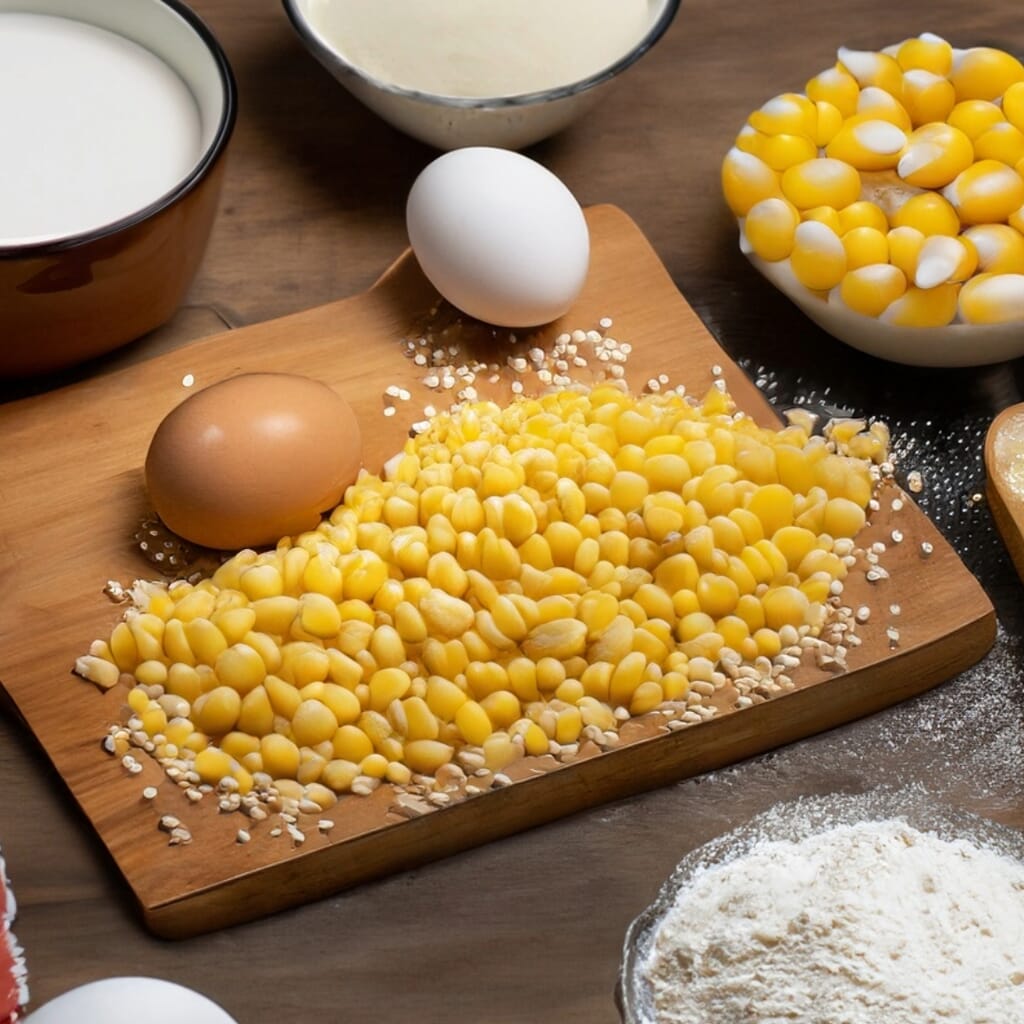
Recipe Directions
Preparation
- In a bowl, combine flour, salt, and beaten egg. Using your fingers, blend until the mixture feels crumbly.
Cooking
- Set a pot with chicken broth to boil gently. Once boiling, add the flour mixture and crushed corn kernels. Allow the soup to cook for roughly 10 minutes. The rivels will transform, taking on an appearance similar to boiled rice when done.
Serving
- Ladle the soup into bowls. For extra flair, garnish with fresh herbs. Serve hot, and enjoy!
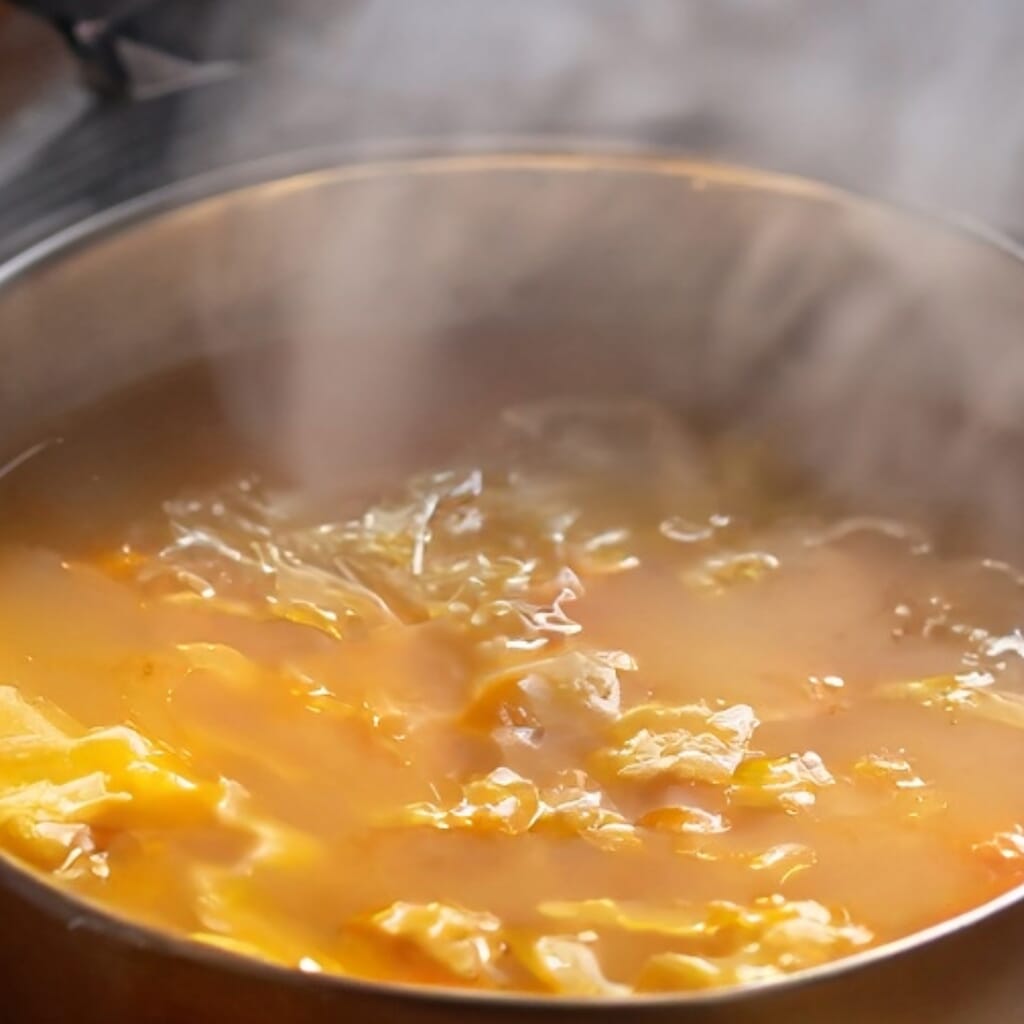
Variations, Add-Ons, And Toppings
Meat Variations
- Chicken: Adding shredded chicken turns the soup into a hearty and dumpling-like dish.
- Beef: Diced beef or beef shreds can give the soup a robust flavor.
- Pork: Consider adding cooked bacon bits or ham pieces for a smoky touch.
Vegetable Add-Ons
- Greens: Spinach, kale, or Swiss chard can be stirred toward the end for added nutrition and color.
- Root Vegetables: Potatoes, carrots, or parsnips can be diced and simmered in the soup for a fuller meal.
- Mushrooms: Sliced mushrooms offer an earthy flavor.
Grains and Legumes
- Barley or Rice: Either can be added for a different texture and to make the soup more filling.
- Beans: Kidney beans, white beans, or chickpeas can enhance the protein content.
Herbs and Spices
- Fresh Herbs: Dill, parsley, or cilantro can be sprinkled on top before serving.
- Warm Spices: A pinch of nutmeg or paprika can offer a depth of flavor.
Dairy and Non-Dairy
- Cream: A splash of cream can make the soup richer and creamier.
- Coconut Milk: For a dairy-free variation, coconut milk offers a creamy texture and a hint of sweetness.
Toppings
- Cheese: Grated Parmesan, cheddar, or crumbled feta can be sprinkled on top for a salty kick.
- Nuts: Toasted almonds or pine nuts can add a crunchy texture.
- Croutons: Homemade or store-bought, these add a satisfying crunch to the soup.
- Green Onions: Sliced thinly, they offer a fresh bite and a burst of color.
Acidity and Heat
- Lemon: A squeeze of lemon juice can brighten up the soup.
- Chili Flakes: A sprinkle of red chili flakes does the trick for those who like a little heat.
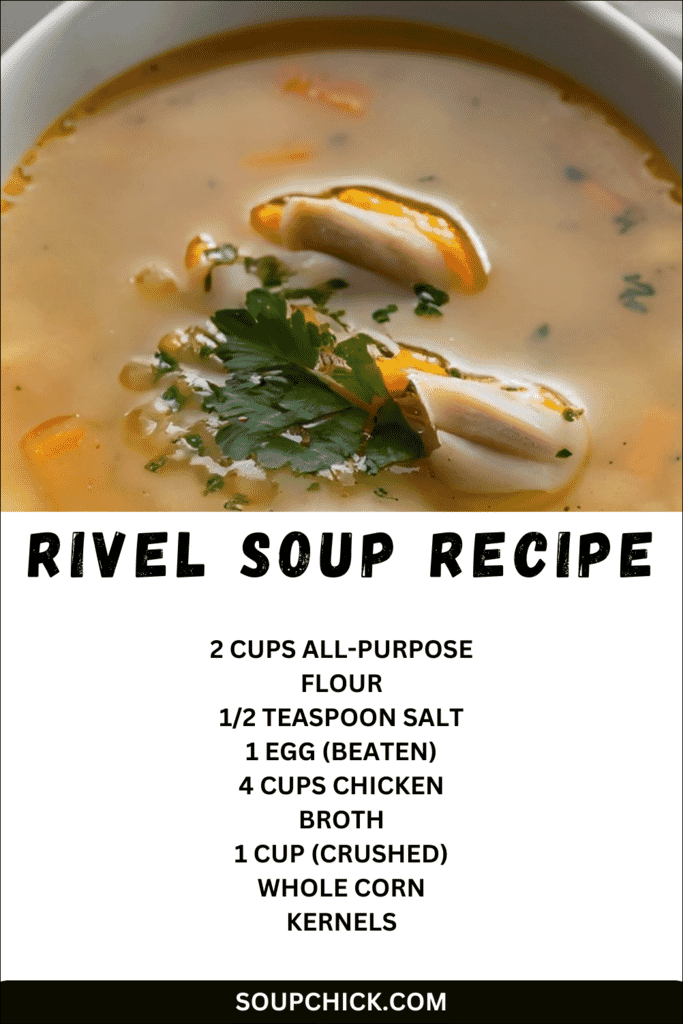
Can I Make Rivel Soup In A Slow Cooker Or Instant Pot?
The slow cooker and the Instant Pot can be adapted to make Rivel Soup. Here’s how you can do it for each appliance:
Slow Cooker
- If making the broth from scratch, add your chicken or vegetables, water, and seasoning to the slow cooker and let it cook on low for 6-8 hours or high for 3-4 hours.
- Once the broth is ready, strain out any solids, and return the broth to the slow cooker.
- Turn the slow cooker high and wait for the broth to become hot.
- Combine the flour, salt, and beaten egg until the mixture crumbles.
- Add the mixture and crushed corn kernels to the hot broth in the slow cooker.
- Cook on high for 30-40 minutes or until the rivels resemble boiled rice.
- Serve hot.
Instant Pot
- Use the ‘Sauté’ function to heat the broth if using store-bought or pre-made broth. Add chicken or vegetables, water, and seasoning to make broth from scratch. Pressure cook on high for 25-30 minutes, then do a quick release.
- Once the broth is ready, strain out any solids.
- Turn on the ‘Sauté’ function again to keep the broth hot.
- While the broth heats, combine flour, salt, and beaten egg in a bowl until crumbly.
- Add the crumbly mixture and crushed corn kernels to the Instant Pot.
- Let the soup simmer for 10 minutes on the ‘Sauté’ setting or until the rivels look like boiled rice.
- Turn off the Instant Pot and serve immediately.
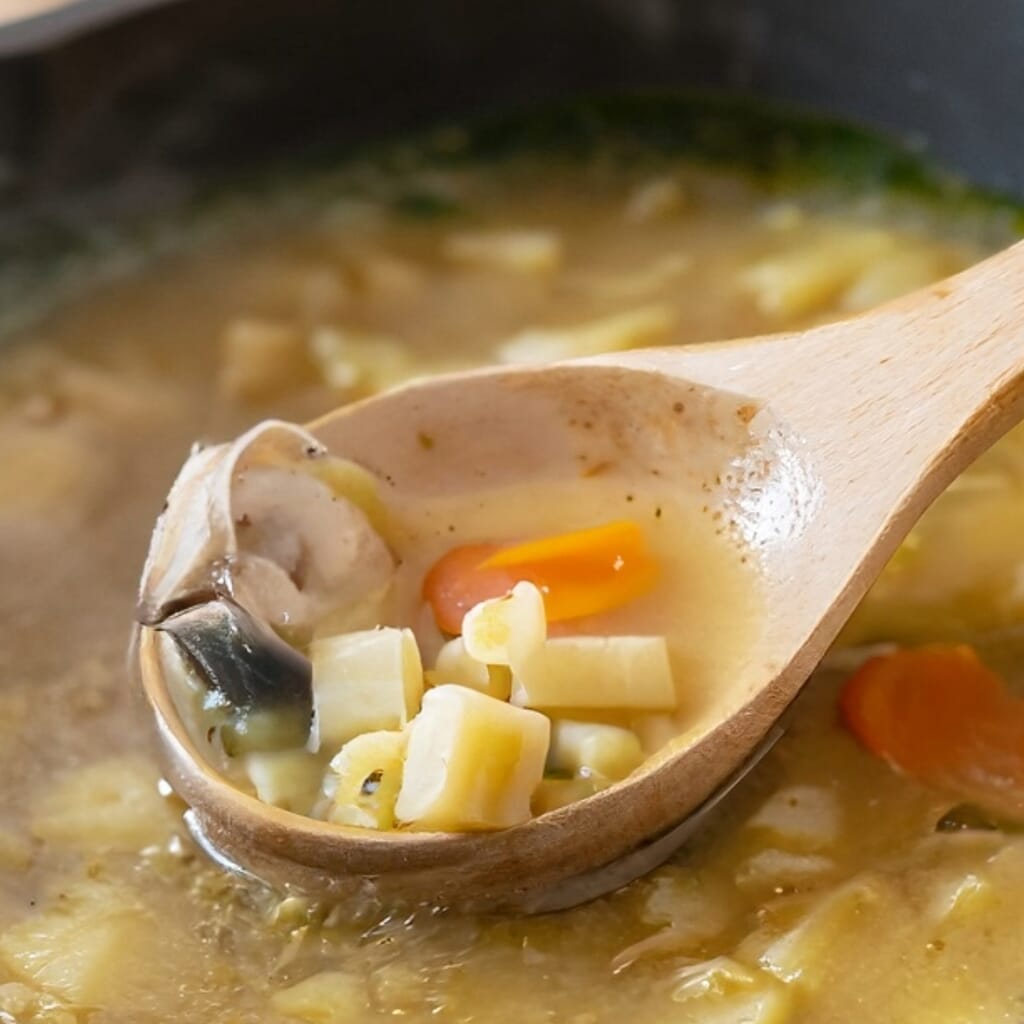
Can I Use Store Bought Broth, Or Should I Make My Own?
Store-bought broth and homemade broth have their advantages. They can be used based on your preferences, time constraints, and desired flavor profile. Here’s a comparison to help you decide:
Store-Bought Broth
- Convenience: Grabbing a carton or can of broth from the store is undoubtedly quicker than making your own, especially if you need more time.
- Consistency: Store-bought broths typically have a consistent flavor, so you know what you’re getting each time.
- Variety: Many brands offer organic, low-sodium, and specialty flavors, giving you various options.
Homemade Broth
- Flavor Control: You have complete control over the flavor. You can adjust the herbs, spices, and ingredients to your liking.
- No Additives: Homemade broth doesn’t have any preservatives or additives.
- Cost-Effective: Making broth home can be economical, especially if you use kitchen scraps like vegetable peels or leftover bones.
- Nutritional Value: Simmering bones for an extended period can extract beneficial nutrients and minerals, resulting in a richer broth.

How To Serve ?
Serving Rivel Soup in a way that elevates its flavors and presentation can enhance the overall dining experience. Here are some suggestions to serve Rivel Soup best:
- Warm Bowls: Before ladling the soup into bowls, warm them up. This ensures the soup stays hot longer. You can warm bowls by rinsing them with hot water or placing them in an oven set to a low temperature for a few minutes.
- Garnish: Enhance the appearance and flavor by adding garnishes. Fresh chopped parsley, chives, or dill can add a touch of color and a new flavor.
- Crusty Bread: Serve Rivel Soup with slices of crusty bread or dinner rolls on the side. The bread complements the soup’s texture and is excellent for dipping.
- Pair with Salad: A fresh green salad with a tangy vinaigrette can balance the hearty nature of the soup, providing a lighter, crunchy contrast.
- Grated Cheese: A sprinkle of freshly grated Parmesan or another hard cheese can add a savory depth to the soup.
- Serve in a Bread Bowl: Hollow out individual round bread loaves and serve the Rivel Soup directly in them for a rustic presentation.

Perfect Side Dishes
- Crusty Bread or Dinner Rolls: Warm, crusty bread is perfect for any soup. It’s great for soaking up the broth and adds a satisfying texture.
- Green Salad: A light and refreshing green salad with a tangy vinaigrette can provide a crisp contrast to the hearty soup.
- Roasted Vegetables: Roasted root vegetables like carrots, parsnips, and beets can be a warm side that complements the flavors of the soup.
- Grilled Cheese Sandwich: A crispy grilled cheese sandwich can be a decadent and delightful partner to the soup, allowing for dipping and a combination of textures.
- Pickled Vegetables: Offering a side of pickles, be it cucumber, beets, or radishes, can add a tangy contrast to the soup’s flavors.
- Slaw: A coleslaw, tangy apple, and carrot slaw can add a crunchy, refreshing element to the meal.
- Quiche or Savory Tart: A slice of a light quiche or a savory vegetable tart can round out the meal, offering protein and a different texture.
- Bruschetta: Garlic-rubbed toasted slices of baguette topped with diced tomatoes, basil, and a drizzle of olive oil can be a flavorful and textured complement.
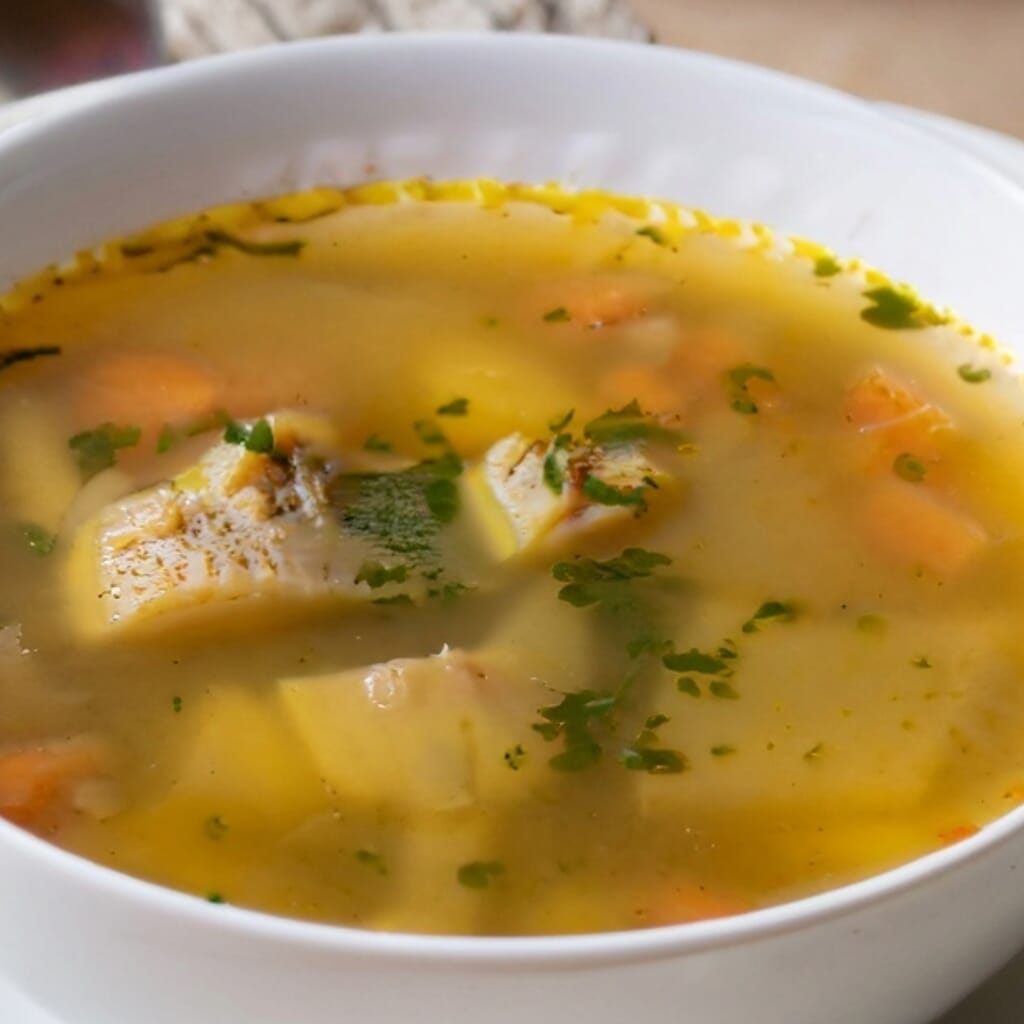
Storage And Make Ahead
- Storage: Allow the soup to cool completely before transferring it to an airtight container. Store in the refrigerator for up to 3-4 days. Reheat gently on the stovetop, adding a little water or broth if needed to reach the desired consistency.
- Make Ahead: Prepare the soup as directed but without adding the rivels. Allow the soup base to cool completely before transferring it to an airtight container. Store in the refrigerator for up to 2 days. When ready to serve, reheat the soup base on the stovetop, bring it to a simmer, and then add the rivels and cook as directed. This ensures the rivels remain firm and delicious.

What Can We Do With Leftovers?
Leftovers offer a delightful chance to get creative! Here’s what you can do with leftover Rivel Soup:
- Refresh and Serve: Reheat and adjust seasonings, possibly adding fresh herbs for a renewed flavor.
- Rice Add-in: Stir into cooked rice for a soupy risotto-like dish.
- Pasta Dish: Combine with pasta, perhaps with a sprinkle of cheese.
- Casserole Base: Use a base for a baked casserole, adding vegetables and a breadcrumb topping.
- Pie Filling: Make a savory pie using the soup as the filling.
- Bread Bowl: Serve inside hollowed-out bread for a hearty meal.
- Freeze for Later: Store in freezer-safe containers for a quick future meal.
- Thicken for Stew: Reduce on the stove, adding meat or veggies for a thicker stew.
- Mix with Grains: Blend with quinoa or couscous for a textured dish.
- Wrap or Burrito: Add greens or proteins as a moist filling for wraps or burritos.
TIPS
- Toast the flour before adding it to the soup for a nuttier flavor.
- Use a mix of butter and oil for sautéing the vegetables for richness.
- Add a pinch of nutmeg or allspice to enhance the soup’s aroma.
- For a heartier texture, mix in some cooked shredded chicken.
- Incorporate fresh herbs like parsley or dill at the end for a burst of freshness.
- Serve the soup with a dollop of sour cream or yogurt for a creamy finish.
- Try adding a splash of white wine for a slightly acidic note.
- Use homemade chicken or vegetable broth for the best flavor.
Nutrition Table
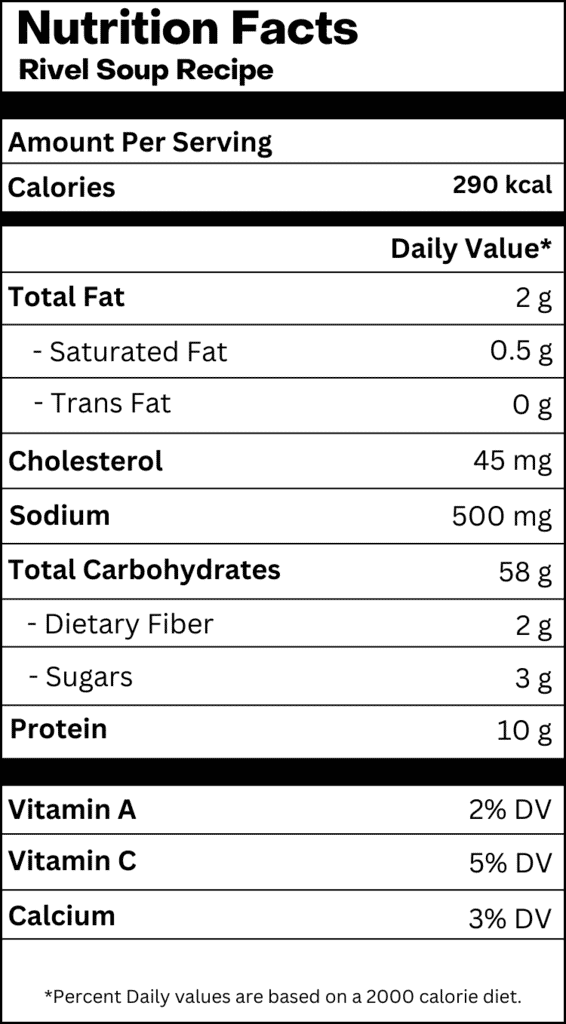
- How To Make Butternut Squash Soup Recipe – Easy And Delicious - February 13, 2024
- Perfect Chinese Chicken Soup Recipe – A Delightful Feast - October 3, 2023
- Easy Red Pepper Soup Recipe (Sweet-Mild Flavors) - October 3, 2023

